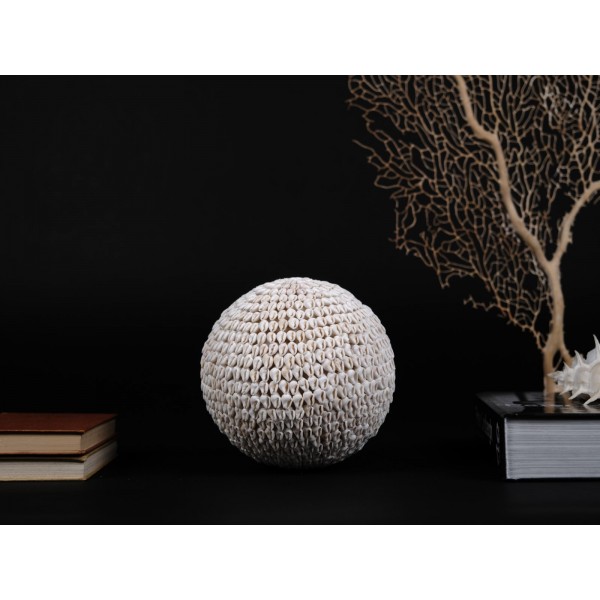Marine composition
Beautiful marine composition, looking like big mushrooms, made with shark vertebrae, from Madagascar and Scottish sea urchins, from North sea in a black lacquered wood base.
| close |
This shop uses cookies to improve your experience on our website. |
Reference: N1051
A beautiful Shell ball made with Strombidae shells, from Indonesia.
These balls are part of the Indo-Pacific cultural heritage, and from a long time tribal people use them as adornment pieces. Today they are natural and beautiful decor pieces.
Dimensions: 14 cm diameter
Weight: 349 g

A beautiful Shell ball made with Strombidae shells, from Indonesia.
These balls are part of the Indo-Pacific cultural heritage, and from a long time tribal people use them as adornment pieces. Today they are natural and beautiful decor pieces.
Beautiful marine composition, looking like big mushrooms, made with shark vertebrae, from Madagascar and Scottish sea urchins, from North sea in a black lacquered wood base.
Syrinx aruanius - Australian Trumpet shell in a dark brass base.
It's a species of extremely large sea snail measuring up to 91 cm long and weighing up to 18 kg. Shells over 50 cm are now impossible to obtain, specially in good condition. It is a marine gastropod mollusk in the family Turbinellidae, and is the only species in the genus Syrinx.
This one is open into an spiral shape, handmade by local artisans from Indonesia.
A unique big glass vitrine with a massive black lacquered wood base. Displaying an exceptional selection of three Haliotis cracherodi polished, showing its colors and patterns, from Baja California - USA, three Haliotis midae polished with the usual bronze colors and dramatic pattern, from R.S.A. and two Haliotis rubra with great mother-of-pearl shinning from South Australia.
Handmade One of a Kind piece!
Spondylus usually attach themselves to rocks, corals, anything from time to time we found some surprising attachments, here we have a beautiful Sopndylus echinatus, from Philippines, attached in a black gorgonia trunk, making this piece very special.
Mounted in an acrylic base.
A great decor item, displaying 18 white specimens of coral, shells, urchins and other exotic marine animals in a big glass dome.
Supplied with full data of all specimen.
A One of a Kind piece!
A big size perfect Festilyria festiva from Somalia.
A classic rarity, very hard to get in this size and condition, for the serious collector or for decor beautiful shell.
Maoricardium pseudolima (commonly known as the Giant African Cockle) – This highly sought-after and edible mollusk is now overfished, with large specimens becoming increasingly rare. This particular piece comes from a batch collected over 30 years ago in the coastal waters north of Mombasa, Kenya.
The Giant African Cockle, with its large size and vibrant coloring, thrives buried in coral sand bottoms in the western Indian Ocean. In addition to its striking appearance, the meat of this mollusk is known for making a substantial and flavorful meal.
A beautiful Shell ball made with Umbonium vestiarium shells, from Indonesia.
These balls are part of the Indo-Pacific cultural heritage, and from a long time tribal people use them as adornment pieces. Today they are natural and beautiful decor pieces.
Giant Barrel Sponge (Xestospongia testudinaria) is a giant species of sponge found in the Indo-Pacific coral reefs. It commonly occurs at depths ranging from over 10 meters to 120 meters and can grow up to a diameter of 1.8 meters. The sponge typically exhibits a brownish-red to brownish-gray coloration, with a hard or stony texture. Due to its impressive size and estimated lifespan of hundreds to possibly thousands of years, the giant barrel sponge has earned the nickname "redwood of the reef." It displays a variable form, often appearing as a large, firm, barrel-shaped structure with a cone-shaped cavity at the top called the osculum. These sponges make beautiful decorative pieces. The specimen in question originates from Luzon, Philippines.
Superb pair of Hexaplex cichoreus from Balicasag, Philippines.
This intricated species is very variable in pattern and color, along the years we have had exceptional pieces, these ones are of great beauty.
Mounted in a black lacquered wood base.
A giant size glass dome with a selection of nine superb Spondylus.
One Spondylus regius from Philippines, three Spondylus americanus from Brazil, one Spondylus gloriosus visayensis from Philippines, one Spondylus aurantius from Philippines, one Spondylus varius from Philippines and two Spondylus ictericus from Brazil.
Unique One of a Kind decor piece!
An exceptional specimen of pinna nobilis, from Greece, in a black lacquered wood frame .
The specimen came from a old collection, today is impossible to get this size specimen.
One of a Kind decor piece!
A colorful marine glass dome displaying an Acropora humilis coral, two Sugar Sea stars, two Alphonso Sea urchins, one purple sea urchin, two white knobbed urchins and two Mithrodia clavigera.
Beautiful decor piece for sea lovers!
The two valves of a giant Acesta philippinarum, very rare, perfect condition in a pair of black lacquered wood pedestals.
These came from deep water, in tangle nets - from Balicasag island, Philippines.
Superb pair of Hexaplex cichoreus from Balicasag, Philippines.
This intricated species is very variable in pattern and color, along the years we have had exceptional pieces, these ones are of great beauty.
Mounted in a black lacquered wood base.
Giant Barrel Sponge (Xestospongia testudinaria) is a giant species of sponge found in the Indo-Pacific coral reefs. It commonly occurs at depths ranging from over 10 meters to 120 meters and can grow up to a diameter of 1.8 meters. The sponge typically exhibits a brownish-red to brownish-gray coloration, with a hard or stony texture. Due to its impressive size and estimated lifespan of hundreds to possibly thousands of years, the giant barrel sponge has earned the nickname "redwood of the reef." It displays a variable form, often appearing as a large, firm, barrel-shaped structure with a cone-shaped cavity at the top called the osculum. These sponges make beautiful decorative pieces. The specimen in question originates from Luzon, Philippines.